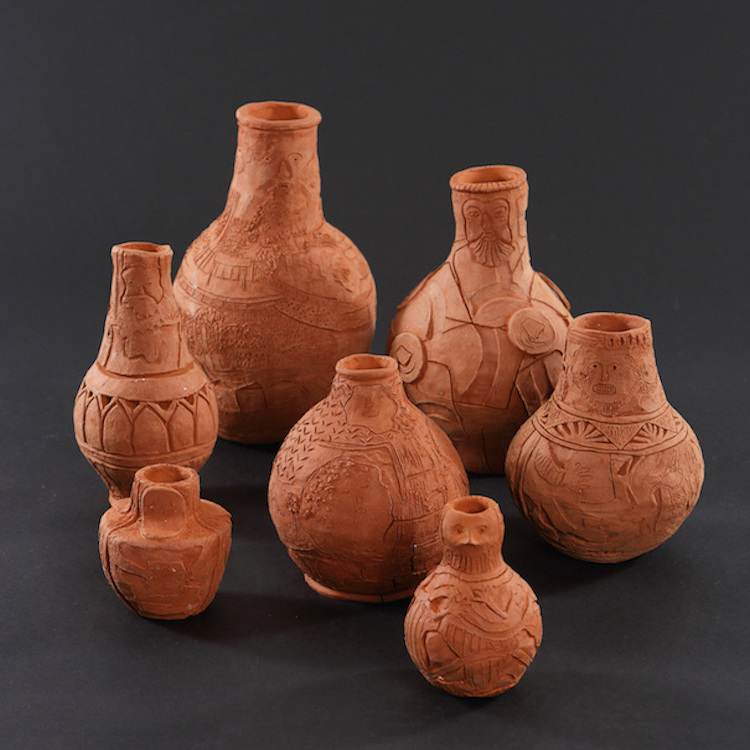The following ceramic objects in our photo essay are made from clay sourced from an unusual place – the earth 100 feet below the London Bridge Station. The London Bridge Clay Project at the Southwark Cathedral (London, England, through March 5, 2017) is comprised of works from eight members of the Associated Clay Workers Union reflecting South London’s rail network. And, at 100 feet below ground, the clay was laid down approximately 54 million years ago – the number equal to the number of commuters who will pass through the station this year.
Above Image: Amy Leung, Bartmann Jugs
Inspired by the sight of a pilling machine digging up the earth at the London Bridge Station, ceramist Alison Cooke approached the excavating company, who turned over nearly 800 pounds of earth to the artist organization. The donation was nearly pure clay, so the ceramists processed the spoil through fine mesh sieves to remove stones and grit, to then be dried and wedged for use.
The dark grey clay known to excavators as “London Blue” was challenging to work with, prone to cracking, bloating and discoloration. It has been rarely used in its raw form outside the brick-making industry. ACWU decided to avoid mixing it with commercial additives that could have removed its unpredictabilities and embrace the natural behavior of the clay. The resulting works are collaborative efforts between each artist and the earth below.

Alison Cooke, Platform 6
Platform 6 at London Bridge, until recently, held the title of the busiest platform in Britain. This work is part of a series of train wheels with carved tracks in groups of 6 or 9, numbers which relate to the future track layout of “terminating” and “through” platforms. The components have been under and over-fired, in reference to the 1212 Great Fire of Southwark and only thing that has changed to the clay in millions of years, the temperature. – Alison Cooke

Bea Denton, Transience and transubstantiation

Duncan Hooson, Fancy Goods

Jo Pearl, Votive Feet
Inspired by a 1st Century Roman oil lamp in the shape of a foot, excavated by archaeologists from under London Bridge Station, I decided to make a series of three ceramic votive feet. The first is a recreation of the Roman find, the second more closely linked to the terracotta votive offerings made to the gods to ask for the healing of ailments. The third, my response to a sense that we have shot ourselves in the foot with the BREXIT vote and my fears for the union of the United Kingdom. – Jo Pearl

Diane Eagles, Pipes
The London Bridge train station opened in December 1836. The tobacco pipes mark the industries and history particular to the area, and inspired by the Tooley Street/Joiners Street tobacco pipe, found during the archaeological work carried out prior to the current development. – Diane Eagles

Taking part in the Project: Row 1: Stephanie Buttle, Alison Cooke, Bea Denton, Diane Eagles Row 2: Duncan Hooson, Amy Leung, Jo Pearl, Matt Raw.
Explore more works from the London Bridge Project.
Do you love or loathe these works of contemporary ceramics and contemporary ceramic art. Let us know your thoughts in the comments.

Whitney thanks for the inclusion in cFile.daily. The exhibition about this work has been extended for the third time until 14th March, it is on display in Southwark Cathedral close by the place where the clay was dug up! So if your readers are in London please do check it out! (nearest underground station London Bridge)